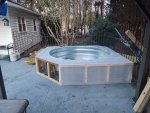I'm working on building us a stock tank hot tub/pool. Based on what I can find in the NEC (not that I'm incredibly familiar with it) this pool doesn't necessarily qualify to need bonding. It's well below 42" and I think whether it would be considered portable is a grey area. It could well be drained and moved but we don't plan to ever do so. I'm not sure why having water levels of less than 42" would protect us in the event of an electrical fault vs 43".
However I'd like to have it all bonded anyway. The pump will be a double insulated intex pump but the heater is not double insulated. Everything will be powered from gfci receptacles or breakers.
My biggest question here, as I read about bonding above ground pools with steel panels, it reads that if all panels are bolted together, the pool walls need only be bonded in one location as it all ties together. I interpret that to mean this galvanized stock tank need only be bonded with one lug to bond the entire tank.
My next question, since there is no liner, if the tank is properly bonded, since it is in constant contact with the water the water itself is also bonded, no?
If not I will purchase an in line water bonding kit or one of the kits that replaces the drain plug in the pump.
Once it is all set up, I will test the bonding at various points around the pool and to the pool equipment per Mike Holt's instructional videos, but I hope to get it all right the first time.
This tank will be on a corner of the concrete patio that is around our IGP, so I assume I should, or at least that it will be good to, bond this to the bonding grid for the patio and the big pool. I can access that fairly easily near the location for this tub.
I realize that my questions did not address bonding the heater or anything else and that will be done, I'm just curious whether, in this situation, bonding the tank also bonds the water so I don't need to order anything else.
However I'd like to have it all bonded anyway. The pump will be a double insulated intex pump but the heater is not double insulated. Everything will be powered from gfci receptacles or breakers.
My biggest question here, as I read about bonding above ground pools with steel panels, it reads that if all panels are bolted together, the pool walls need only be bonded in one location as it all ties together. I interpret that to mean this galvanized stock tank need only be bonded with one lug to bond the entire tank.
My next question, since there is no liner, if the tank is properly bonded, since it is in constant contact with the water the water itself is also bonded, no?
If not I will purchase an in line water bonding kit or one of the kits that replaces the drain plug in the pump.
Once it is all set up, I will test the bonding at various points around the pool and to the pool equipment per Mike Holt's instructional videos, but I hope to get it all right the first time.
This tank will be on a corner of the concrete patio that is around our IGP, so I assume I should, or at least that it will be good to, bond this to the bonding grid for the patio and the big pool. I can access that fairly easily near the location for this tub.
I realize that my questions did not address bonding the heater or anything else and that will be done, I'm just curious whether, in this situation, bonding the tank also bonds the water so I don't need to order anything else.


